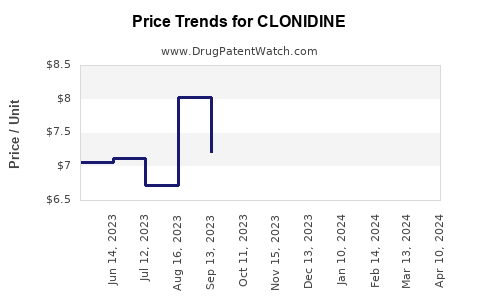Drug Price Trends for CLONIDINE
✉ Email this page to a colleague

Average Pharmacy Cost for CLONIDINE
| Drug Name | NDC | Price/Unit ($) | Unit | Date |
|---|---|---|---|---|
| CLONIDINE 0.1 MG/DAY PATCH | 00378-0871-99 | 5.91672 | EACH | 2024-04-17 |
| CLONIDINE 0.1 MG/DAY PATCH | 51862-0453-04 | 5.91672 | EACH | 2024-04-17 |
| CLONIDINE 0.1 MG/DAY PATCH | 51862-0453-01 | 5.91672 | EACH | 2024-04-17 |
| CLONIDINE 0.1 MG/DAY PATCH | 00591-3508-04 | 5.91672 | EACH | 2024-04-17 |
| CLONIDINE HCL ER 0.1 MG TABLET | 69238-1426-06 | 0.26442 | EACH | 2024-04-17 |
| CLONIDINE 0.1 MG/DAY PATCH | 00378-0871-16 | 5.91672 | EACH | 2024-04-17 |
| >Drug Name | >NDC | >Price/Unit ($) | >Unit | >Date |
Best Wholesale Price for CLONIDINE
| Drug Name | Vendor | NDC | Count | Price ($) | Price/Unit ($) | Unit | Dates | Price Type |
|---|---|---|---|---|---|---|---|---|
| DURACLON 100MCG/ML INJ | Mylan Institutional LLC | 67457-0218-10 | 10ML | 13.14 | 1.31400 | ML | 2024-01-01 - 2028-09-28 | Big4 |
| DURACLON 100MCG/ML INJ | Mylan Institutional LLC | 67457-0218-10 | 10ML | 23.12 | 2.31200 | ML | 2024-01-01 - 2028-09-28 | FSS |
| DURACLON 100MCG/ML INJ | Mylan Institutional LLC | 67457-0218-10 | 10ML | 12.10 | 1.21000 | ML | 2023-09-29 - 2028-09-28 | Big4 |
| DURACLON 100MCG/ML INJ | Mylan Institutional LLC | 67457-0218-10 | 10ML | 12.10 | 1.21000 | ML | 2023-09-29 - 2028-09-28 | FSS |
| DURACLON 100MCG/ML INJ | Mylan Institutional LLC | 67457-0218-10 | 10ML | 23.12 | 2.31200 | ML | 2023-10-12 - 2028-09-28 | FSS |
| CLONIDINE 0.1MG/24HRS PATCH | AvKare, LLC | 00591-3508-04 | 4 | 46.04 | 11.51000 | EACH | 2023-06-15 - 2028-06-14 | FSS |
| >Drug Name | >Vendor | >NDC | >Count | >Price ($) | >Price/Unit ($) | >Unit | >Dates | >Price Type |


